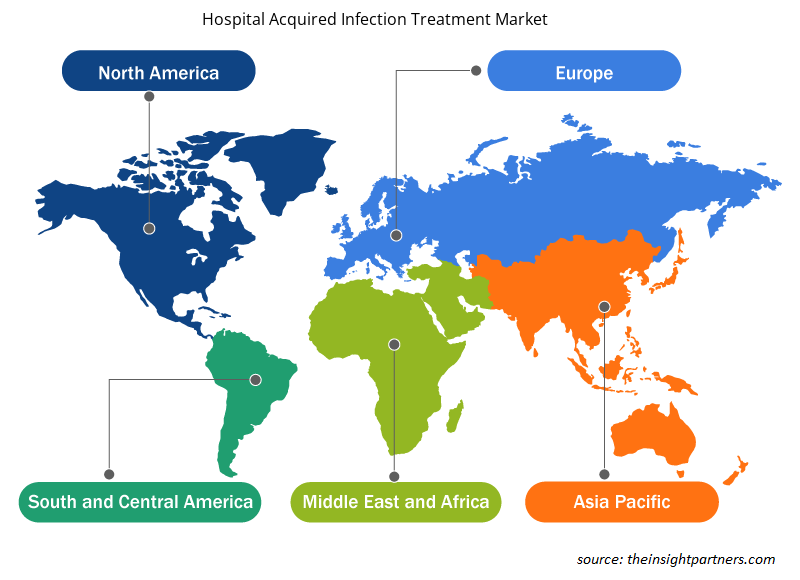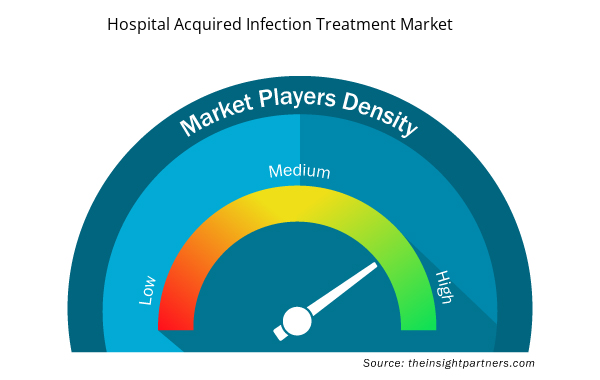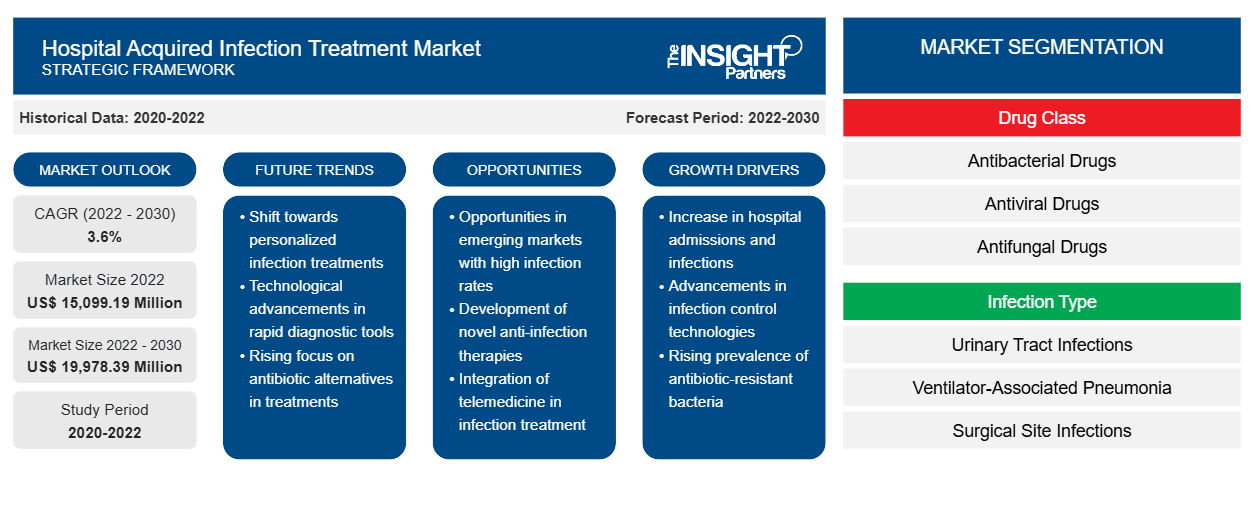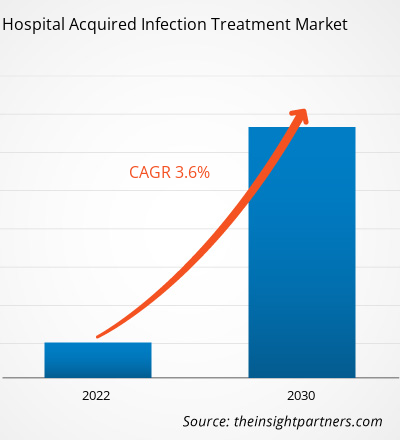[調査レポート]院内感染治療市場は、2022年の150億9,919万米ドルから2030年には199億7,839万米ドルに成長すると予想されており、2022年から2030年にかけて3.6%のCAGRを記録すると予想されています。
市場洞察とアナリストの見解:
院内感染とも呼ばれる院内感染 (HAI) は、病院、長期療養施設、外来診療所など、さまざまな環境で発生する可能性があり、退院後にも発生することがあります。また、HAI には、医療従事者に影響を与える職業感染も含まれる場合があります。院内感染治療市場の成長を牽引する主な要因は、HAI の蔓延率の高さと、患者の安全と質の高いケアへの関心の高まりです。ただし、抗菌薬耐性の脅威が院内感染治療市場の成長を妨げています。
成長の原動力と制約:
中心静脈カテーテル関連血流感染症、カテーテル関連尿路感染症、人工呼吸器関連肺炎は、医療関連感染症(HAI)のいくつかの例として挙げられます。手術部位感染症として知られるこれらの感染症は、手術部位でも発生する可能性があります。2021年に発行された米国疾病予防管理センター(CDC)の報告書「2020年全国および州医療関連感染症進捗報告書」によると、2019年から2020年にかけて、米国では中心静脈カテーテル関連血流感染症、メチシリン耐性黄色ブドウ球菌(MRSA)菌血症、人工呼吸器関連イベントの症例がそれぞれ24%、35%、15%増加しました。
さらに、全米医療安全ネットワーク(NHSN)の2022年1月のレポートによると、尿路感染症(UTI)は医療関連感染症の中で5番目に多いタイプです。UTIは急性期病院の病状の9.5%以上を占めています。カテーテル関連尿路感染症(CAUTI)は、膀胱から尿を排出するために使用される尿道カテーテルによって引き起こされます。CAUTIは、入院中のUTI患者の間で最も頻繁に起こる感染症の1つです。疾病管理予防センター(CDC)によると、感染症の約75%は尿道カテーテルに関連しています。入院中、入院患者の15%から25%は尿道カテーテルを使用する必要があります。尿道カテーテルの長期使用は、CAUTIになる最も大きな危険因子です。CAUTIの合併症は、患者の苦しみ、入院期間の延長、治療費の増加、さらには死亡を伴います。
さらに、CDC によると、UTI は毎年 13,000 人以上の死因となっています。急性の単純性膀胱炎は、約 6 日間の不快感を引き起こし、毎年約 700 万人が受診し、16 億ドルの費用がかかります。その結果、HAI 症例数の増加は医療制度に大きな財政的負担をかけています。CAUTI の有病率の増加と治療薬の需要増加が相まって、市場が成長しています。
しかし、抗菌薬耐性は院内感染治療にとって大きな課題となっており、既存の抗菌薬の有効性が制限され、耐性病原体に効果的に対抗するための新たな治療戦略や抗菌薬の代替品の開発が必要になります。
要件に合わせてレポートをカスタマイズする
このレポートの一部、国レベルの分析、Excelデータパックなど、あらゆるレポートを無料でカスタマイズできます。また、スタートアップや大学向けのお得なオファーや割引もご利用いただけます。
- このレポートの主要な市場動向を入手してください。この無料サンプルには、市場動向から見積もりや予測に至るまでのデータ分析が含まれます。
レポートのセグメンテーションと範囲:
世界の院内感染治療市場は、薬剤クラス、感染タイプ、流通チャネルに基づいてセグメント化されています。薬剤クラスに基づいて、院内感染治療市場は抗菌薬、 抗ウイルス薬、抗真菌薬、その他に分類されています。感染タイプに基づいて、院内感染治療は、尿路感染症、人工呼吸器関連肺炎、手術部位感染症、血流感染症、その他の院内感染症に分類されています。流通チャネルに基づいて、市場は病院薬局、小売薬局、電子商取引、その他に分類されています。院内感染治療市場は、地域別に、北米(米国、カナダ、メキシコ)、欧州(ドイツ、フランス、イタリア、英国、ロシア、その他の欧州)、アジア太平洋(オーストラリア、中国、日本、インド、韓国、その他のアジア太平洋)、中東およびアフリカ(南アフリカ、サウジアラビア、UAE、その他の中東およびアフリカ)、南米および中米(ブラジル、アルゼンチン、その他の南米および中米)に分類されています。
セグメント分析:
院内感染治療市場は、薬剤クラス別に、抗菌薬、抗ウイルス薬、抗真菌薬、その他に分類されています。抗菌薬セグメントは2022年に最大の市場シェアを占め、2022年から2030年にかけて最高のCAGRを記録すると予想されています。
院内感染治療市場は、感染タイプ別に、尿路感染症、人工呼吸器関連肺炎、手術部位感染症、血流感染症、その他の院内感染に分類されます。尿路感染症セグメントは2022年に最大の市場シェアを占めました。ただし、人工呼吸器関連肺炎セグメントは、2022年から2030年にかけて最高のCAGRを記録すると予想されています。
院内感染治療市場は、流通チャネル別に、病院薬局、小売薬局、電子商取引、その他に分類されています。2022年には、病院薬局セグメントが最大の市場シェアを占め、同じセグメントが2022年から2030年の間に最高のCAGRを記録すると予想されています。
地域分析:
地理に基づいて、世界の院内感染症治療市場は、北米、ヨーロッパ、アジア太平洋、南米および中米、中東およびアフリカの 5 つの主要地域に分類されます。
2022年、北米は世界の院内感染治療市場規模で最大のシェアを占めました。米国ではHAIの有病率が高く、院内感染治療市場の成長を牽引しています。CDCによると、どの日でも、入院患者の約31人に1人が少なくとも1つのHAIに罹患しています。同様に、疾病予防・健康増進局によると、HAIやその他の感染症は敗血症につながる可能性があり、米国では年間約170万人の病気と27万人の死を引き起こしています。このように、米国の人々のHAIの有病率の高さは、院内感染治療市場の成長を促進しています。
業界の発展と将来の機会:
世界の院内感染治療市場で活動する主要企業が行っているさまざまな取り組みを以下に示します。
- 2023年5月、イノビバ・スペシャリティ・セラピューティクスは、米国食品医薬品局(FDA)が、アシネトバクター・バウマニ・カルコアセティカス複合体(アシネトバクター)の感受性分離株によって引き起こされる院内細菌性肺炎および人工呼吸器関連細菌性肺炎(HABP/VABP)の治療薬として、18歳以上の患者を対象に静脈内投与用に包装されたXACDURO(注射用スルバクタム、注射用デュロバクタム)を承認したと発表しました。イノビバ・スペシャリティ・セラピューティクスは、救命救急および感染症における革新的な治療法の提供に注力していると述べました。
- 2023年5月、プネのインド科学教育研究機関(IISER)とラクナウの中央医薬品研究所(CSIR-CDRI)の研究者らは、頻繁に院内感染を引き起こすアシネトバクター・バウマニに対する潜在的な新しい抗生物質を発見したと発表しました。
- 2020年9月、塩野義製薬は、エンテロバクター・クロアカエ複合体、クレブシエラ・ニューモニエ、アシネトバクター・バウマニ複合体、大腸菌、緑膿菌、セラチア・マルセセンスなどの感受性グラム陰性微生物によって引き起こされる院内細菌性肺炎および人工呼吸器関連細菌性肺炎(HABP/VABP)を患う18歳以上の患者の治療薬として、FETROJA(セフィデロコル)の追加新薬申請(sNDA)がFDAにより承認されたと発表しました。
- 2020年6月、メルク社は、米国食品医薬品局(FDA)がRECARBRIO(イミペネム、シラスタチン、リレバクタム)の追加新薬申請(sNDA)を承認したと発表しました。RECARBRIOは、アシネトバクター・カルコアセティカス・バウマニ複合体、クレブシエラ・オキシトカ、クレブシエラ・ニューモニエ、エンテロバクター・クロアカエ、大腸菌、インフルエンザ菌、クレブシエラ・アエロゲネス、緑膿菌、セラチア・マルセセンスなどの感受性グラム陰性微生物によって引き起こされる院内細菌性肺炎および人工呼吸器関連細菌性肺炎(HABP/VABP)を患っている18歳以上の患者の治療薬として承認されました。
院内感染治療市場の地域別分析
予測期間を通じて院内感染治療市場に影響を与える地域的な傾向と要因は、Insight Partners のアナリストによって徹底的に説明されています。このセクションでは、北米、ヨーロッパ、アジア太平洋、中東、アフリカ、南米、中米にわたる院内感染治療市場のセグメントと地理についても説明します。

- 院内感染治療市場の地域別データを入手
院内感染治療市場レポートの範囲
| レポート属性 | 詳細 |
|---|---|
| 2022年の市場規模 | 150億9,919万米ドル |
| 2030年までの市場規模 | 199億7,839万米ドル |
| 世界のCAGR(2022年 - 2030年) | 3.6% |
| 履歴データ | 2020-2022 |
| 予測期間 | 2022-2030 |
| 対象セグメント | 薬物クラス別
|
| 対象地域と国 | 北米
|
| 市場リーダーと主要企業プロフィール |
|
院内感染治療市場のプレーヤー密度:ビジネスダイナミクスへの影響を理解する
院内感染治療市場は、消費者の嗜好の変化、技術の進歩、製品の利点に対する認識の高まりなどの要因により、エンドユーザーの需要が高まり、急速に成長しています。需要が高まるにつれて、企業は提供内容を拡大し、消費者のニーズを満たすために革新し、新たなトレンドを活用し、市場の成長をさらに促進しています。
市場プレーヤー密度とは、特定の市場または業界内で活動している企業または会社の分布を指します。これは、特定の市場スペースに、その市場規模または総市場価値に対してどれだけの競合相手 (市場プレーヤー) が存在するかを示します。
院内感染症治療市場で事業を展開している主要企業は次のとおりです。
- メルク社
- ファイザー株式会社
- アッヴィ株式会社
- パラテック製薬株式会社
- ユージアUS LLC
免責事項:上記の企業は、特定の順序でランク付けされていません。

- 院内感染治療市場のトップキープレーヤーの概要を入手
競争環境と主要企業:
Merck & Co Inc、Pfizer Inc、AbbVie Inc、Paratek Pharmaceuticals Inc、Eugia US LLC、Abbott Laboratories、Cumberland Pharmaceuticals Inc、Innoviva Specialty Therapeutics Inc、Cipla Ltd、およびEli Lilly and Companyは、院内感染治療市場で活動する有力企業です。これらの企業は、新しい技術、既存製品の改良、地理的拡大に注力し、世界中で高まる消費者の需要に対応し、専門ポートフォリオの製品範囲を拡大しています。
- 過去2年間の分析、基準年、CAGRによる予測(7年間)
- PEST分析とSWOT分析
- 市場規模価値/数量 - 世界、地域、国
- 業界と競争環境
- Excel データセット



Report Coverage
Revenue forecast, Company Analysis, Industry landscape, Growth factors, and Trends

Segment Covered
This text is related
to segments covered.

Regional Scope
North America, Europe, Asia Pacific, Middle East & Africa, South & Central America

Country Scope
This text is related
to country scope.
よくある質問
Hospital-acquired infections (HAI), also known as nosocomially acquired infections. HAIs are infections acquired during medical treatment that were not present at the time of admission. They may develop in a variety of settings, including hospitals, long-term care institutions, and ambulatory settings, and they can also appear after discharge. HAIs can also involve occupational infections that affect healthcare workers.
The hospital acquired infection treatment market majorly consists of the players, including Merck & Co Inc, Pfizer Inc, AbbVie Inc, Paratek Pharmaceuticals Inc, Eugia US LLC, Abbott Laboratories, Cumberland Pharmaceuticals Inc, Innoviva Specialty Therapeutics Inc, Cipla Ltd, and Eli Lilly and Company.
Key factors driving the hospital acquired infection treatment market growth include the high prevalence of hospital-acquired infections (HAI) and the growing focus on patient safety and quality care.
The hospital acquired infection treatment market was valued at US$ 15,099.19 million in 2022.
The hospital acquired infection treatment market, by distribution channel, is segmented into hospital pharmacies, retail pharmacies, e-commerce, and others. In 2022, the hospitals pharmacies segment held the largest market share, and the same segment is anticipated to register the highest CAGR during 2022–2030.
The hospital acquired infection treatment market is expected to be valued at US$ 19,978.39 million in 2030.
The hospital acquired infection treatment market, by infection type, is segmented into urinary tract infections, ventilator-associated pneumonia, surgical site infections, bloodstream infections, and other hospital infections. The urinary tract infections segment held a larger market share in 2022; However, the ventilator-associated pneumonia segment is anticipated to register a higher CAGR during 2022-2030.
The hospital acquired infection treatment market, by drug class, is segmented into antibacterial drugs, antiviral drugs, antifungal drugs, and others. The antibacterial drugs segment held a larger market share in 2022, and the same segment is anticipated to register a higher CAGR during 2022-2030.
Trends and growth analysis reports related to Life Sciences : READ MORE..
The List of Companies - Hospital Acquired Infection Treatment Market
- Merck & Co Inc
- Pfizer Inc
- AbbVie Inc
- Paratek Pharmaceuticals Inc
- Eugia US LLC
- Abbott Laboratories
- Cumberland Pharmaceuticals Inc
- Innoviva Specialty Therapeutics Inc
- Cipla Ltd
- Eli Lilly and Company
The Insight Partners performs research in 4 major stages: Data Collection & Secondary Research, Primary Research, Data Analysis and Data Triangulation & Final Review.
- Data Collection and Secondary Research:
As a market research and consulting firm operating from a decade, we have published and advised several client across the globe. First step for any study will start with an assessment of currently available data and insights from existing reports. Further, historical and current market information is collected from Investor Presentations, Annual Reports, SEC Filings, etc., and other information related to company’s performance and market positioning are gathered from Paid Databases (Factiva, Hoovers, and Reuters) and various other publications available in public domain.
Several associations trade associates, technical forums, institutes, societies and organization are accessed to gain technical as well as market related insights through their publications such as research papers, blogs and press releases related to the studies are referred to get cues about the market. Further, white papers, journals, magazines, and other news articles published in last 3 years are scrutinized and analyzed to understand the current market trends.
- Primary Research:
The primarily interview analysis comprise of data obtained from industry participants interview and answers to survey questions gathered by in-house primary team.
For primary research, interviews are conducted with industry experts/CEOs/Marketing Managers/VPs/Subject Matter Experts from both demand and supply side to get a 360-degree view of the market. The primary team conducts several interviews based on the complexity of the markets to understand the various market trends and dynamics which makes research more credible and precise.
A typical research interview fulfils the following functions:
- Provides first-hand information on the market size, market trends, growth trends, competitive landscape, and outlook
- Validates and strengthens in-house secondary research findings
- Develops the analysis team’s expertise and market understanding
Primary research involves email interactions and telephone interviews for each market, category, segment, and sub-segment across geographies. The participants who typically take part in such a process include, but are not limited to:
- Industry participants: VPs, business development managers, market intelligence managers and national sales managers
- Outside experts: Valuation experts, research analysts and key opinion leaders specializing in the electronics and semiconductor industry.
Below is the breakup of our primary respondents by company, designation, and region:

Once we receive the confirmation from primary research sources or primary respondents, we finalize the base year market estimation and forecast the data as per the macroeconomic and microeconomic factors assessed during data collection.
- Data Analysis:
Once data is validated through both secondary as well as primary respondents, we finalize the market estimations by hypothesis formulation and factor analysis at regional and country level.
- Macro-Economic Factor Analysis:
We analyse macroeconomic indicators such the gross domestic product (GDP), increase in the demand for goods and services across industries, technological advancement, regional economic growth, governmental policies, the influence of COVID-19, PEST analysis, and other aspects. This analysis aids in setting benchmarks for various nations/regions and approximating market splits. Additionally, the general trend of the aforementioned components aid in determining the market's development possibilities.
- Country Level Data:
Various factors that are especially aligned to the country are taken into account to determine the market size for a certain area and country, including the presence of vendors, such as headquarters and offices, the country's GDP, demand patterns, and industry growth. To comprehend the market dynamics for the nation, a number of growth variables, inhibitors, application areas, and current market trends are researched. The aforementioned elements aid in determining the country's overall market's growth potential.
- Company Profile:
The “Table of Contents” is formulated by listing and analyzing more than 25 - 30 companies operating in the market ecosystem across geographies. However, we profile only 10 companies as a standard practice in our syndicate reports. These 10 companies comprise leading, emerging, and regional players. Nonetheless, our analysis is not restricted to the 10 listed companies, we also analyze other companies present in the market to develop a holistic view and understand the prevailing trends. The “Company Profiles” section in the report covers key facts, business description, products & services, financial information, SWOT analysis, and key developments. The financial information presented is extracted from the annual reports and official documents of the publicly listed companies. Upon collecting the information for the sections of respective companies, we verify them via various primary sources and then compile the data in respective company profiles. The company level information helps us in deriving the base number as well as in forecasting the market size.
- Developing Base Number:
Aggregation of sales statistics (2020-2022) and macro-economic factor, and other secondary and primary research insights are utilized to arrive at base number and related market shares for 2022. The data gaps are identified in this step and relevant market data is analyzed, collected from paid primary interviews or databases. On finalizing the base year market size, forecasts are developed on the basis of macro-economic, industry and market growth factors and company level analysis.
- Data Triangulation and Final Review:
The market findings and base year market size calculations are validated from supply as well as demand side. Demand side validations are based on macro-economic factor analysis and benchmarks for respective regions and countries. In case of supply side validations, revenues of major companies are estimated (in case not available) based on industry benchmark, approximate number of employees, product portfolio, and primary interviews revenues are gathered. Further revenue from target product/service segment is assessed to avoid overshooting of market statistics. In case of heavy deviations between supply and demand side values, all thes steps are repeated to achieve synchronization.
We follow an iterative model, wherein we share our research findings with Subject Matter Experts (SME’s) and Key Opinion Leaders (KOLs) until consensus view of the market is not formulated – this model negates any drastic deviation in the opinions of experts. Only validated and universally acceptable research findings are quoted in our reports.
We have important check points that we use to validate our research findings – which we call – data triangulation, where we validate the information, we generate from secondary sources with primary interviews and then we re-validate with our internal data bases and Subject matter experts. This comprehensive model enables us to deliver high quality, reliable data in shortest possible time.


 このレポートの無料サンプルを入手する
このレポートの無料サンプルを入手する